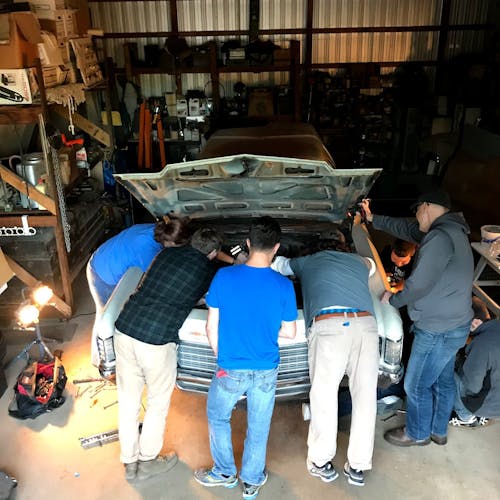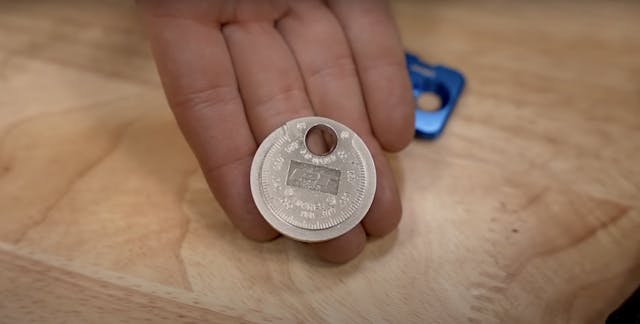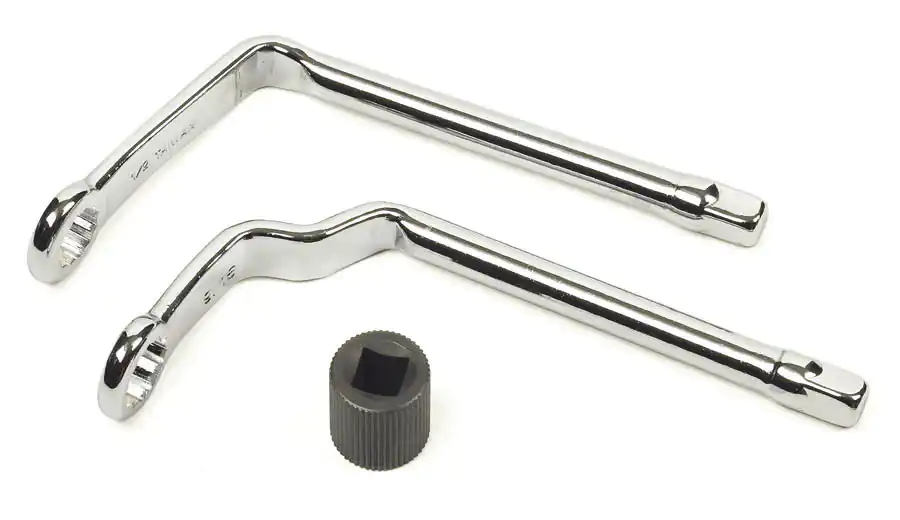9 old tools almost nobody uses anymore

The nuts and bolts that make up our beloved automobiles have not changed that much over the last 150 years. But the tools needed to maintain them? Those have changed a lot. Software has cemented itself as part of a service technician’s day-to-day regimen, relegating a handful of tools to the history books. (Or, perhaps, to niche shops or private garages that keep many aging cars alive and on the road.)
How many of these now-obsolete tools do you have in your garage? More to the point, which are you still regularly using?
Spark-plug gap tool

Though spark-plug gap tools can still be found in the “impulse buy” section of your favorite parts store, these have been all but eliminated from regular use by the growing popularity of iridium and platinum plugs. These rare-earth metals are extremely resistant to degradation but, when it comes time to set the proper gap between the ground strap and electrode, they are very delicate. That’s why the factory sets the gap when the plug is produced.
These modern plugs often work well in older engines, meaning that gapping plugs is left for luddites—those who like doing things the old way just because. Nothing wrong with that; but don’t be surprised if dedicated plug-gapping tools fade from common usage fairly quickly.
Verdict: Keep. Takes up no real space.
Dwell meter

50 years ago, a tuneup of an engine centered on the ignition system. The breaker points are critical to a properly functioning ignition system, and timing how long those points are closed (the “dwell”) determines how much charge is built up in the ignition coil and thus discharged through the spark plug. Poorly timed ignition discharge is wasted energy, but points-based ignition systems disappeared from factory floors decades ago, and drop-in electronic ignition setups have never been more reliable (or polarizing—but we’ll leave that verdict up to you.)
Setting the point gap properly is usually enough to keep an engine running well, and modern multifunction timing lights can include a dwell meter for those who really need it. A dedicated dwell meter is an outdated tool for a modern mechanic, and thus most of the vintage ones are left to estate sales and online auction sites.
Verdict: Toss once it stops working. Modern versions are affordable and multifunctional.
Distributor wrench

When mechanics did a lot of regular timing adjustments and tuning, a purposely bent distributor wrench made their lives much easier. However, much like ignition points, distributors have all but disappeared. Thanks to coil-on-plug ignition systems and computer-controlled timing, the distributor is little more than a messenger: It simply tells the computer where the engine is at in its rotation.
Timing adjustments have become so uncommon that a job-specific tool is likely a waste of space. If you’ve got room in your tool chest, keep yours around; but know that a standard box-end wrench can usually get the job done and is only fractionally less convenient than the specialized version.
Verdict: Keep if you have them. No need to buy if you don’t.
Pre-OBDII diagnostic scan tools

Prior to the required standardization of on-board diagnostic computers by the U.S. in 1996, a single car could host a wild mix of analog and digital diagnostic methods. OBDII, which stands for On-Board Diagnostic II, wasn’t the first time that a small computer was used to pull information from the vehicle via an electronic connection; it merely standardized the language.
Throughout the 1980s and early 1990s each OEM had its own version of a scan tool. Now those tools can be reverse-engineered and functionally spoofed by a modern computer, allowing access to diagnostic info tools that, at the time, were only available to dealers. Since many pre-OBDII cars are now treated as classics or antiques and driven far less frequently, the need for period-correct diagnostic tools is dropping.
Verdict: Keep. These will only get harder to find with time, and working versions will be even rarer.
Distributor machine
A distributor is simple in concept. Trying to balance the performance and economy of the ignition system, with the distributor attached to a running engine, and achieving proper operation starts to get pretty complicated. That’s where a distributor machine comes in.
A distributor is attached to the apparatus and spun at engine speed by an electric motor. This allows you to literally see how the points are opening and closing. You can also evaluate the function of vacuum or mechanical advance systems. These machines are still great but the frequency that this service is needed these days is few and far between, especially when trying to justify keeping a large tool around and properly calibrated.
Verdict: Keep, if you are a specialty shop or tool collector.
Engine analyzer

Even a casual enthusiast can see there is a lot more information that can be gleaned from a running engine than whatever readouts might be on the dash. Enter the engine analyzer, a rolling cabinet of sensors and processors designed to fill in the data gaps between everything that is happening in a car and what its gauges report.
An engine analyzer is essentially a handful of additional instruments packaged into a small box hanging around the bottom of your tool drawers. It can also house a lot of sensors in a giant cabinet, which was likely wheeled into the corner of the shop in 1989 and left to gather dust. Now engine analyzers can be found listed online for as cheap as $200.
The funny thing is that many of the sensors in these engine analyzers are often the same systems that come built into modern dynamometer tuning systems. In a dyno, the sensors allow the operator to see more than max power; they also show how changes to an engine’s tune affect emissions. Maybe engine analyzers didn’t disappear so much as change clothes.
Verdict: Toss. The opportunity cost of the space these take up can be tough for most home garages. Sensors went out of calibration decades ago so the information you might get from one is dubious at best.
Most pneumatic tools (for home shops)

Air tools hold an odd place in the hearts of many gearheads. For many years the high-pitched zizzzz and chugging hammers of air-driven die grinders and impact drills were the marks of a pro. Or, at least, of someone who decided that plumbing high-pressure air lines around the shop was easier than installing outlets and maintaining corded tools. Air tools are fantastic for heavy use, as they are much easier to maintain and can be rebuilt and serviced.
Those tools can really suffer in lack of use, though, since pneumatic tools rely on seals and valves, neither of which deal well with dry storage. Battery tools have caught up to air tools for most DIY folk. No more air lines or compressors taking up space in the shop—and requiring additional maintenance—and, in return, a similarly sized yet more agile tool.
Verdict: Keep, if you already have the compressor. Don’t have one? Invest in battery tools.
Babbitt bearing molds/machining jigs
Every engine rebuild has to have bearings made for it in some fashion. Today’s cars use insert bearings that are mass-produced to surgical tolerances for a multitude of applications. If you wanted—or more accurately needed—new bearings in your Model T circa 1920, you needed to produce your own … in place … inside the engine. Welcome to Babbitt bearings.
The process is a true art form, from the setup of the jigs to the chemistry of pouring molten metal and machining the resulting orbs to actually fit the crankshaft and connecting rods. Now there are newly cast blocks for your T that replace the Babbitt with insert bearings. Since those antique Ford engines just don’t get abused the way they used to, and lead fairly pampered lives, they need rebuilding far less often than they did in-period. Modern oils also do a better job of protecting these delicate bearings. Since they are less and less in demand, the tooling and knowledge to make Babbitt bearings are difficult to find, and precious when you do.
Verdict: Keep. It’s literally critical to keeping a generation of cars alive.
Split-rim tire tools

Among the realm of scary-looking tools that have earned their infamy, split-rim tools hold court. The concept is simple: The rim is sectioned, allowing it to contort into a slight spiral that can be “screwed” into a tire. (This is almost the reverse of a modern tire machine, which stretches the tire around a solid wheel rim.) When tires needed tubes, both tire and rim were relatively fragile, and the roads were rough, split rims were popular—and for good reason. Now the tooling for drop-center wheels is ubiquitous and shops often won’t take on split-rim work. Success is hard to guarantee, even if techs are familiar with split rims—and they rarely are.
Verdict: Keep. No substitute for the right tools with this job.
***
These tools might not make much sense in a dealership technician’s work bay, but that doesn’t mean they should disappear forever. Knowing how to service antiquated technology is as important as ever, whether using old tools or new ones. If you’ve got any of these items, consider it your responsibility to document what the tool does and how to safely use it. Keeping alive the knowledge of where our modern tools came from is powerful.
***
Check out the Hagerty Media homepage so you don’t miss a single story, or better yet, bookmark it. To get our best stories delivered right to your inbox, subscribe to our newsletters.


I was given a Sun Distributor Tester built circa 1947. There is a person who builds and supplies electronic kits for these vintage machines which put it right up there with the Big Boy machines. This one now looks and works great. I have, also, the matching Sun Engine Analyzer–presently not operational but it’s all there.
I have original Manuals for both of these machines.
Since my friends and I work with vintage VW Beetles, Karmann Ghias and T-2s, etc, a staple tool is the spark plug gapping tool/gauge. I never am without one of those (or more than one) in my tool box! Is also used to set the Valves.
I also had an EDM company to recreate a very special Bosch Distributor Points Plate Return Spring Adjuster. These tools are either gone forever or the knowledgeable tool guys are not turning them loose. Thus, I paid a high price for mine. And–it works great! Go try to find someone who even knows what one of these is! It is a treasure–and, it works on those vintage Bosch Distributors.
Wow! Lot’s of reading material here and not enough time right now. – Please clarify; 1995 base Corvette LT-1- OBD1, or OBD2? Thanks!!!
Two of my brothers and I went to a swap meet one time and a guy had a line boring equipment that he was trying to sell. At the time I was in my early 20’s (I am 73 now) and I told the guy I knew what it was for. His reply was “What?” I told it him it was to line bore Model T and Model A Ford engines. I showed him which holes to set up on for the Model T and which ones were for the Model A. He asked how I knew and I told him that I work in a machine shop that has an identical unit. He told me that I was with only 2 , or 3 other people that knew what it was for. He tried to give me a good deal on it, but I turned it down.
I have an Ingersoll Rand 1/2 inch drive impact gun that I bought new in 1975, has never failed me yet and the best bang for the buck lug nut remover on the planet. If you have a compressor and are equipped for so nothing beats pneumatic for durability. Yes cordless and corded electric have a place and I do use them but for brute torque hard to beat air tools.
Electric impact guns don’t have the power of a Chicago Pneumatic. I have both and trust me, if the battery one doesn’t hammer it off the CP will. If it doesn’t, then get out the torch. Also, I’ve read a lot of stuff from guys with their understanding about points, condensers and coils. They must have been reading books, not writing from experience. Old cars don’t run on theory, they run because us old guys have knowledge learned from our dumb mistakes. (Mine anyway)
I have an old Stewart Warner hand held friction Tachometer for old cars with no tach.. Also built an old HeathKit automotive oscilloscope with 12 volt inverter for on the road testing. Still works. Does anybody remember the old Champion Pocket Spark Tester? Just hold it next to spark plug wire to test for spark.
Old GM Tech1A Analyzer is handy with its exercising capability, reprograming, freeze frame capability. Works on every brand GM sold back in the day. Remember ShopSmith? Lathe that can be set up as grinder, belt sander , drill press, and others with attachments. Very versatile. Mine is 53 vintage, leather belt drive.
Having a compressor is essential in any serious home shop. Compressed air is very handy. IE: bead blasters, filling tires in seconds and cleaning up debris with a blow gun. Pneumatic tools will out perform any battery powered tool in both their power and longevity. The battery powered impact set I do own (I won’t name the manufacturer but it was expensive) failed after 5 years due to the battery packs that will cost me about $325 to replace. Air power forever!!
Sixty some odd years ago, my father gave me a set of Gray’s wrenches, his WW II “Tommy Bar” (braker bar), distributer wrenches, timing light, spark plug gapper, and other “old” items previously mentioned. I also have an OBD 1 & 2 instrument for my 1985 Vette, 2000 Jeep Cherokee and 2003 Venza.. All useful; don’t throw the baby with the bath water!
I think engine analyzers, distributor testers and spark plug cleaners are worth preserving as collector’s items and garage decor even if the practical value is gone.
My dwell meter still slumbers alongside my timing light and vacuum gauge waiting for the day I need to work on a classic with points. Admittedly that may be a while, I last had a car with breaker points in 1989 and I converted my motorcycle to electronic ignition in 2003. This makes me wonder how many people would recognize the vaguely cylindrical doohickey in my tool box as a dummy advancer shaft for setting BMW Airhead breaker points.
You might still need a spark plug gap tool to check new plugs before they are installed because the factory gap may not always match the recommended gap for the vehicle. As for checking worn plugs, I just pulled a set of platinum plugs from my wife’s KIA minivan with 127,000 miles on them. The gap was still within specs and showed no wear. So I put them back in.
My friend has two Sun Distributor machines in his garage. They have been restored to 100% perfect operating condition. He uses them to run a small business rebuilding / restoring Marelli distributors – Ferrari, Maserati, Lancia and a few others use these complex devices. I wrote an article about what he does for Forza Magazine and a quote from the piece from the business owner is that everyone he gets in the shop needs serious service. A recent client sent him 2 distributors for a 1960s vintage Ferrari with the complaint that the engine has no power, despite great compression, etc. When the restored distributors were installed he called saying that the car ran perfectly with lots of power! So, these machines have a purpose and can turn a so-so performing Italian exotic into a fast, reliable and fun classic. Maybe Hagerty could use an article on the process, I know a guy who can write it (wink, wink, nudge, nudge…)
I still have my Champion spark plug gap gauge on my key chain. I got it in 1988 after finishing my auto mechanics class during my senior year of high school.
Several tools revolve around ignition points that in these seldom used vehicles literally last forever, maybe longer than the electronic replacements. Very simple and very reliable is hard to beat.
You’ve clearly not owned a late aughts through early 2010s Hyundai product.
Factory gap was too big and the coilpacks would get weak and cause misfires. Instead of replacing 4 coilpacks at $70/ea on my ex’s ’07 accent, I gapped the plugs to .027 from .035 and it ran happy until she sold it 4 years later.
Also the genesis coupes would get blowout at higher boost unless you tightened the gap.
Actually, boost in general kinda makes the gapping tool a key thing to keep around.
I still have and use my Whitworth/BSF ( British standard Fine ) spanner / socket sets along with AF and Metric . Various Timing lights preswsure / vaccum gauges etc, how can anyone maintain a pre 1980 vehicle without the ” Old Fashioned ” tooling, Thereagain, probably the most useful tool in my workshop is a 1924 9″Lathe rescued from a derelict WW2 submarine which will screw cut both metric and imperial threads.